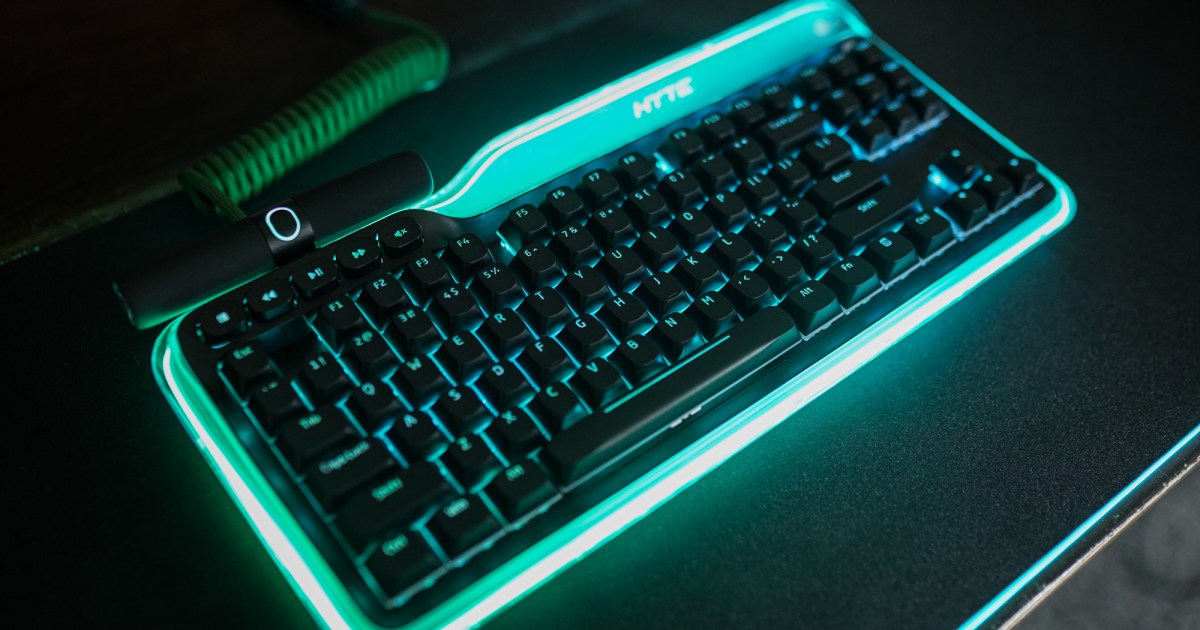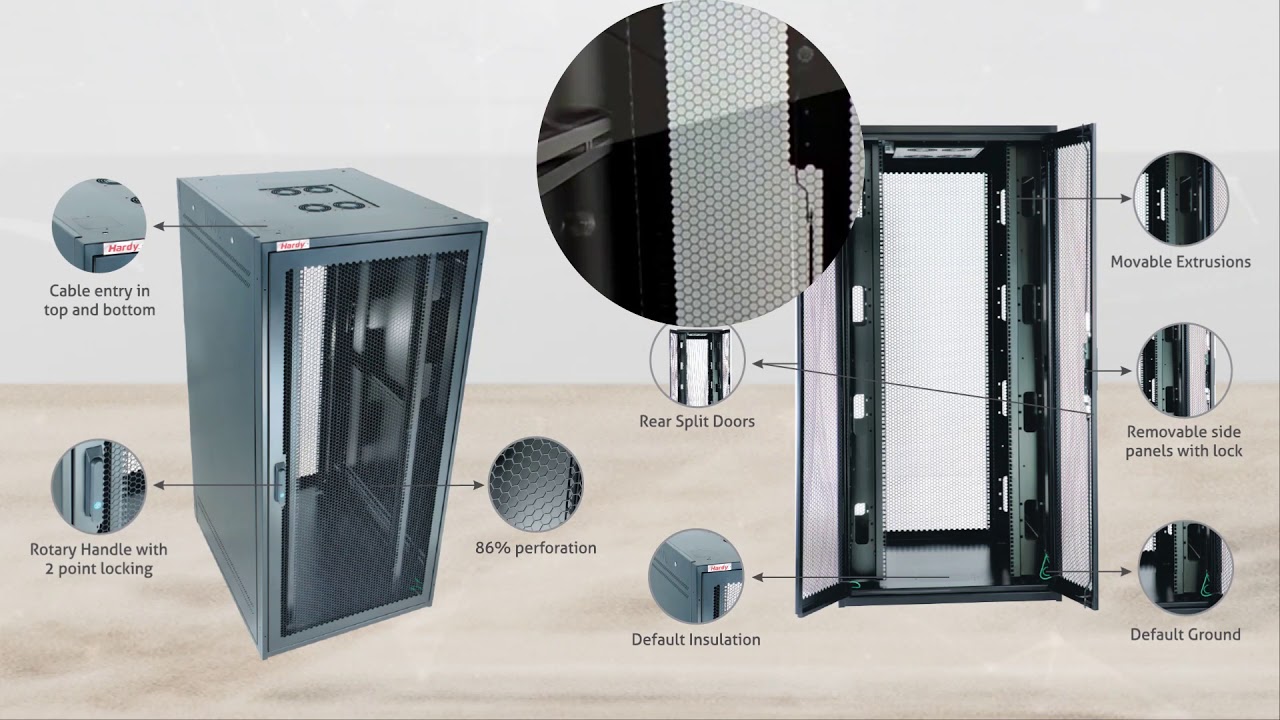Here’s the thing about asking investors for money: they want to see returns.
Technology
Hyte Keeb TKL review: a keyboard for the fans


Hyte Keeb TKL
MSRP $180.00
Pros
- Fantastic sound and feel out of the box
- Up to four layers of key assignments
- Extremely bright RGB lighting
- Hot-swappable PCB
- Multi-function dual rotary dials
Cons
- No per-key RGB
- Only two on-board profiles
- Inconsistent legends on key caps
One look at the photo above, and you’ll know immediately if you love or hate the Hyte Keeb TKL. I can save you some time and let you know immediately that it’s one of the best gaming keyboards you can buy when it comes to sound and feel. But the Keeb TKL is a statement, and although it’s a statement I’m sure will resonate with some, it’s not one that will resonate with all.
The Keeb TKL sets out to do something different, all while paying careful attention to the enthusiast-level features that have slowly made their way into mainstream gaming keyboards. And it mostly succeeds. Short of some software issues, this is a keyboard with a fantastic typing feel out of the box and an undeniably unique design.
Hyte Keeb TKL specs
| Hyte Keeb TKL | |
| Layout | Tenkeyless |
| Keyboard type | Mechanical |
| Switches | Hyte Fluffy Lavender (Linear, 36gf) |
| Switch mount | Gasket |
| Hot-swappable | Yes, 3- or 5-pin |
| Stablizers | Durock V2 screw-in w/ Krytox 205g0 |
| Key caps | Double-shot PBT |
| Backlight | RGB (no per-key assignment)+ 155-pixel qRGB array |
| Construction | Aluminum plate and weight, polycarbonate shell |
| Foam | PCB: IXPE + Poron / Plate: Poron |
| Onboard storage | 2 profiles |
| Software | Hyte Nexus |
| Connection | Wired USB-C |
| Polling rate | 1,000Hz |
| USB ports | N/A |
| Dimensions | 380 x 180 x 53mm |
| Weight | 2.73 pounds |
| List price | $180 |
| Where to buy |
An undeniable design

One thing’s for sure — you’ll never mistake the Hyte Keeb TKL for another keyboard. Hyte is known for pushing the design envelope with products like the Hyte Y70 Touch, but the Keeb TKL is undoubtedly its most radical design to date. One look at this keyboard, and you’ll either love it or hate it. If nothing else, the Keeb TKL demands a reaction, even if it isn’t a positive one, and you can’t say the same for keyboards like the Razer Black Widow V4 Pro.
It’s not for everyone, but I’ve grown to appreciate what Hyte pulled off here. You would never assume there’s a lot of design space to take a keyboard in another direction, but Hyte managed to do that with the Keeb TKL. The star of the show is the polycarbonate shell that surrounds the Keeb TKL, which carries light from the 155-pixel qRGB array around the keyboard (qRGB is Hyte’s own standard for RGB measurement). It makes your keyboard look like it’s floating on a cloud.
Combined with Hyte’s CNVS desk mat, which has its own array of RGB lighting, the Keeb TKL looks fantastic. A slow color wave transitions out of the keyboard and through the edges of the mouse pad. Even against brands like Razer, Corsair, and Steelseries with their own dense RGB ecosystems, the Keeb TKL really brings lighting together.

For more practical design, Hyte includes two magnetic feet on the back of the keyboard allowing you to go from a typing angle of 3.73 degrees to 6.06 degrees (the latter felt much more comfortable for me). You also get a double-shot PBT key caps, which feature a very shallow pudding design. There’s a touch of a transparent layer at the bottom of the key caps, much unlike the large transparent sides you see on traditional pudding key caps.
The construction of the key caps is fantastic. They’re thick, and the tops are smooth, much unlike the gritty feel on something the Asus ROG Strix Scope II 96. Still, there are a couple of issues. They might be too thick for their own good, as lighting through the legends is fairly inconsistent. In addition, Hyte is using the rather unique OEM profile for the key caps. It’s not a knock against the Keeb TKL, but the sculpted corners of the profile is quite the adjustment if you’re coming from a different profile.
Otherwise, Hyte packs a thick aluminum plate into the bottom of the keyboard, which gives it some weight and keeps it firmly seated on your desk. A keyboard weight is far too often overlooked among more mainstream options, so I’m happy to see it here. However, Hyte situates RGB lights around the weight on the bottom of the keyboard, and it gets shockingly warm as a result.
Great out of the box

Hyte calls the Keeb TKL a “modern human interface,” which sets a pretty high standard for the typing feel. And thankfully, the Keeb mostly lives up those expectations. Although the Keeb TKL sports a unique design, it’s clear Hyte invested a lot of time in packing this keyboard full of enthusiast-level hardware. You’re getting a gasket mount like I saw on the Asus ROG Azoth, but that’s becoming fairly common among high-end gaming keyboards. Hyte shoots ahead when it comes to the smaller details.
The switches aren’t just rebranded Cherry options. Hyte uses its Fluffy Lavender switches, which are linear and come with a light feeling compared to Cherry Reds. They have an actuation force of 36 grams and actuate at just 1.5mm. More important to the feel, Hyte lubricates the switches with Kryox 205g0 — the standard for switch lube. In addition, Hyte uses the same lube on the Durock V2 screw-in stabilizers. It’s easy to write off these stabilizers, but they make a world of difference, even up against keyboards like the Corsair K65 Plus.
Hyte definitely excels on sound and feel with the Keeb TKL.
The sound and feel out of the box is shockingly good for a $180 keyboard. I don’t love the use of an aluminum plate, but Hyte balances the high-end frequencies out with various layers of Poron foam inside the case. This is one of the first keyboards I’ve tested that can actually hold up out of the box compared to enthusiast options like the Wobkey Rain75 or Meletrix Boog75.
But you can make it better. Hyte uses a hot-swappable PCB that supports 3- or 5-pin switches, though unfortunately with north-facing RGBs. I threw my preferred WS Morandi switches into the keyboard, and it completely transformed the sound. It’s one thing to get a good sound out of the box, but the real testament to build quality is how the keyboard holds up once you’ve made it your own. Hyte definitely excels on that front with the Keeb TKL.
One unique feature

Hyte packs dedicated media controls into the Keeb TKL, but in true Hyte fashion, they aren’t as straightforward as you might expect. Starting with the media keys, Hyte actually uses low-profile tactile mechanical switches for the media keys, along with low-profile keycaps. They feel completely different than the regular keys, almost like hitting a low-profile typewriter. It’s a small detail, but as someone who actually uses different switches for media keys in my personal keyboard, I can appreciate the attention Hyte paid to that detail.
The more interesting addition are the dual rotary dials. By default, the left dial adjusts your volume while the right adjusts the brightness of your lighting, but you can rebind these dials to other commands within the Hyte Nexus software (more on that next). There are some basic options, such as the ability to scroll pages, zoom, or switch between apps, but Hyte goes further.
You can also use the dials to scrub the timeline in a video editor, cycle your tools in creative apps, and even adjust your brush size in Adobe apps. The dual scroll wheels look a bit unwieldy, and I wish there were a way to remove them. There’s no denying that Hyte makes good use of the extra space, though. It brings some of the tactile control you get with something like the Cooler Master MasterHub directly to your keyboard, which is great to see.
Although the roller apparatus isn’t removable, the dials themselves are. They’re attached with magnets, and Hyte tells me it hopes to have additional accessories for the roller in the future. Those aren’t available now, however.
Inside Hyte Nexus
To manage the Keeb TKL, you’ll need to download the Hyte Nexus software. I first tried this software out with Hyte’s Thicc Q60 cooler, and it’s one of the more interesting software utilities I’ve used. Out of the gate, it’s leagues more attractive than Corsair iCue and Asus Armoury Crate, and it doesn’t immediately overwhelm you with ads or extraneous settings. However, there’s a learning curve to using Nexus. It’s a powerful utility, but like Hyte’s products, the software doesn’t stick with the status quo.
Hyte adopts a focus similar to NZXT’s CAM software, using Nexus as both a utility to manage the Keeb TKL and to show system stats like your GPU and CPU temperatures. These various aspects of the software are grouped into widgets, and you’re free to add, remove, or swap widgets to make the home screen your own.
In the keyboard settings, Hyte gives you two onboard profiles, which is a bit low. However, each of those profiles includes up to four layers of key assignments. By default, the Function key will momentarily unlock your second layer, but you’re free to rebind how you get to the additional layers within Nexus. Hyte includes momentary layer switching, toggles, and even an option to return to your top layer. And in each layer, you can rebind the keys to macros, mouse keys, and functions like opening your web browser. Even with just two onboard profiles, you can pack a ton of functionality into the Keeb TKL if you don’t mind getting your hands dirty.
My main issue with all of these layers is that you can easily get lost in them. Hyte doesn’t give you an option to, for example, change your lighting when switching profiles, which would make it much easier to get your bearings. In fact, Hyte doesn’t give you a lot of lighting options in general. In Nexus, the focus is on an RGB ecosystem, so instead of individual assignments, you place different devices inside of a window so your RGB lighting can stretch across them.
It works well if you have multiple Hyte products, such as the CNVS desk mat, but there’s still no per-key RGB assignment. That’s a huge downside to the Keeb TKL compared to the competition if you like to customize your RGB lighting to fit your unique setup.
Should you buy the Hyte Keeb TKL?

Hyte built a great keyboard with the Keeb TKL between its enthusiast-grade construction and wealth of features. But the biggest factor when it comes to a buying decision is the design. The Keeb TKL demands immediate, and sometimes extreme, reactions. It doesn’t matter how good the keyboard itself is — if you don’t like the design, the Keeb TKL just isn’t for you.
That’s OK. I appreciate how Hyte is attempting to push keyboard designs forward with the Keeb TKL, and how it serves as a statement piece, especially if you have other Hyte products. Not many keyboards can claim that. The good news if you’re a fan of the design is that you don’t have to give up on the keyboard front. Hyte never sacrificed the typing feel in its pursuit of creating a keyboard that stands out, and it’s been a joy typing and gaming on the keyboard over the past few weeks.
Although design is the biggest factor here, there’s some legitimate criticism of the Keeb TKL compared to other mainstream options. Nexus is a powerful app, but it still needs per-key RGB assignments. In addition, the key caps have great construction, but I’d like to see Hyte pay closer attention to the legends in future revisions given the inconsistent shine the current key caps offer.
Technology
Canoo hit with two supplier lawsuits as last remaining co-founder leaves

EV startup Canoo has been hit with two new lawsuits from suppliers linked to the drivetrains that power its electric vehicles, just weeks after the company kicked off a major reorganization that included the departure of its chief technology officer.
Canoo has also parted ways with senior director of advanced vehicle engineering Christoph Kuttner, who was the last remaining co-founder from the team of nine that created the startup in late 2017, TechCrunch has learned.
Kuttner was one of nine co-founders who split off from Faraday Future at the end of 2017 to start up Evelozcity, the original incarnation of Canoo. Those co-founders have steadily slipped away from the company before, during, and after its transition from a private startup to a publicly traded company in late 2020 when it merged with a special purpose acquisition company.
Kuttner and Canoo did not immediately respond to requests for comment.
The supplier lawsuits, both of which were filed in September with Oakland County Circuit Court in Michigan, come at a time when Canoo is moving away from its original California headquarters and focusing increasingly on its operations in Texas and Oklahoma, and while courting potential customers in the U.K. and Middle East. It’s doing all of this on a tight budget. The company reported just a little more than $19 million in total cash, of which $4.5 million was unrestricted, as of June 30, 2024.
The two firms suing Canoo are Jing-Jin Electric North America and Dana Limited. Canoo had tapped Jing-Jin, or JJE, to design and build electric motors for the EV startup’s vehicles. JJE claims Canoo failed to pay for the motors and owed more than $1.4 million as of August 2023. The supplier alleges Canoo didn’t dispute the money owed and then “strung JJE along for months — repeatedly promising to pay JJE, blaming its delay on issues and factors wholly unrelated to JJE.”
In November 2023, according to the complaint, JJE and Canoo entered into a repayment plan to set things right. JJE says Canoo made its first three payments, totaling $851,013, and an additional payment of $120,649.23. But JJE says the payments stopped soon after, despite Canoo owing another $446,692.77. JJE suspended all work for Canoo in June 2024 and says the EV startup stopped responding.
Dana Limited, meanwhile, says it entered an agreement with Canoo in February 2022 to co-design and develop a drive assembly for Canoo’s vehicles. Dana Limited says that as part of the agreement, Canoo was required to compensate the supplier for any costs incurred if the EV startup’s vehicle production was delayed by more than three months.
“Canoo’s production and work under the Agreement was significantly delayed,” Dana Limited writes in the complaint. The supplier now alleges Canoo failed to make two $4.3 million cost recovery payments despite sending “several notices” to the EV startup through late 2023 and into 2024.
Servers computers
Hardy 42U Server Rack Benefits Video

Looking for reliable server racks for your data center?
Here are 10 reasons to choose the premium perforated racks from Hardy Racks!
Number 1.
The front and back sides of the rack come with a total perforation of 86%, an excellent means to dissipate over 3.5 Kilowatts of heat while allowing the free inflow of cool air.
Number 2.
The heavy-duty metal body of the 42U rack comes with a load-bearing capacity of up to 1200 kilograms!
Number 3.
The perforated front door and the perforated, space-saving split rear doors come with a one-click removable feature – and can be fitted or removed without any tools!
Number 4.
The side panels are also detachable. They come with the provision to be kept locked when not in use. These features make the massive 42U rack easy to transport, install, and seamless to work with during maintenance!
Number 5.
The sticker-free numbering of U positions – both from the top to bottom and bottom to top – makes it really convenient for identifying rack positions for installation, troubleshooting and maintenance!
Number 6.
5 cable entries on the top and 5 cable entries at the bottom – provide you with the option to bring in your cables easily, whether you have a raised flooring or false flooring setup in your data center.
Number 7. (04:43 – 04:57)
The rack is spacious enough to handle more than one PDU, which can be mounted at the back of the server rack with the help of the vertical cable manager.
Number 8.
The insulated panes between the doors and walls of the server rack is a safety feature that prevents metal to metal friction which can cause serious damage in heat-producing environments.
Number 9.
6 points of grounding at the bottom, and 1 point of grounding at the top of the rack – an extremely important safety feature for a rack that will be filled with electrical equipment!
Number 10.
The stylish, rotary handle with an in-built lock on the front door takes up virtually no extra space and can be tucked in while not in use.
From toughened body to user-friendly features and all safety amenities required for smooth operations – we have thought of everything!
But don’t just take our word for it!
All our server racks are CE certified – which is the seal of trust that indicates that our products conform to all requisite standards.
Interested in knowing more?
Give us a call at +91 844 844 47 46 or visit www.hardyracks.com.
source
Technology
OpenAI was a research lab — now it’s just another tech company

OpenAI launched with a famously altruistic mission: to help humanity by developing artificial general intelligence. But along the way, it became one of the best-funded companies in Silicon Valley. Now, the tension between those two facts is coming to a head.
Weeks after releasing a new model it claims can “reason,” OpenAI is barreling toward dropping its nonprofit status, some of its most senior employees are leaving, and CEO Sam Altman — who was once briefly ousted over apparent trust concerns — is solidifying his position as one of the most powerful people in tech.
On Wednesday, OpenAI’s longtime chief technology officer, Mira Murati, announced she’s leaving “to create the time and space to do my own exploration.” The same day, chief research officer Bob McGrew and VP of post training Barret Zoph said they would depart as well. Altman called the leadership changes “a natural part of companies” in an X post following Murati’s announcement.
“I obviously won’t pretend it’s natural for this one to be so abrupt, but we are not a normal company,” Altman wrote.
But it follows a trend of departures that’s been building over the past year, following the failed attempt by the board to fire Altman. OpenAI cofounder and chief scientist Ilya Sutskever, who delivered Altman the news of his firing before publicly walking back his criticism, left OpenAI in May. Jan Leike, a key OpenAI researcher, quit just days later, saying that “safety culture and processes have taken a backseat to shiny products.” Nearly all OpenAI board members at the time of the ouster, except Quora CEO Adam D’Angelo, have resigned, and Altman secured a seat.
The company that once fired Altman for being “not consistently candid in his communication” has since been reshaped by him.
No longer just a “donation”
OpenAI started as a nonprofit lab and later grew a for-profit subsidiary, OpenAI LP. The for-profit arm can raise funds to build artificial general intelligence (AGI), but the nonprofit’s mission is to ensure AGI benefits humanity.
In a bright pink box on a webpage about OpenAI’s board structure, the company emphasizes that “it would be wise” to view any investment in OpenAI “in the spirit of a donation” and that investors could “not see any return.”
Investor profits are capped at 100x, with excess returns supporting the nonprofit to prioritize societal benefits over financial gain. And if the for-profit side strays from that mission, the nonprofit side can intervene.
We’re way past the “spirit of a donation” here
Reports claim OpenAI is now approaching a $150 billion valuation — about 37.5 times its reported revenue — with no path toward profitability in sight. It’s looking to raise funds from the likes of Thrive, Apple, and an investment firm backed by the United Arab Emirates, with a minimum investment of a quarter-million dollars.
OpenAI doesn’t have deep pockets or existing established businesses like Google or Meta, which are both building competing models (though it’s worth noting that these are public companies with their own responsibilities to Wall Street.) Fellow AI startup Anthropic, which was founded by former OpenAI researchers, is nipping at OpenAI’s heels while looking to raise new funds at a $40 billion valuation. We’re way past the “spirit of a donation” here.
OpenAI’s “for-profit managed by a non-profit” structure puts it at a moneygrubbing disadvantage. So it made perfect sense that Altman told employees earlier this month that OpenAI would restructure as a for-profit company next year. This week, Bloomberg reported that the company is considering becoming a public benefit corporation (like Anthropic) and that investors are planning to give Altman a 7 percent stake. (Altman almost immediately denied this in a staff meeting, calling it “ludicrous.”)
And crucially, in the course of these changes, OpenAI’s nonprofit parent would reportedly lose control. Only a few weeks after this news was reported, Murati and company were out.
Both Altman and Murati claim that the timing is only coincidental and that the CTO is just looking to leave while the company is on the “upswing.” Murati (through representatives) declined to speak to The Verge about the sudden move. Wojciech Zaremba, one of the last remaining OpenAI cofounders, compared the departures to “the hardships parents faced in the Middle Ages when 6 out of 8 children would die.”
Whatever the reason, this marks an almost total turnover of OpenAI leadership since last year. Besides Altman himself, the last remaining member seen on a September 2023 Wired cover is president and cofounder Greg Brockman, who backed Altman during the coup. But even he’s been on a personal leave of absence since August and isn’t expected to return until next year. The same month he took leave, another cofounder and key leader, John Schulman, left to work for Anthropic.
When reached for comment, OpenAI spokesperson Lindsay McCallum Rémy pointed The Verge to previous comments made to CNBC.
And no longer just a “research lab”
As Leike hinted at with his goodbye message to OpenAI about “shiny products,” turning the research lab into a for-profit company puts many of its long-term employees in an awkward spot. Many likely joined to focus on AI research, not to build and sell products. And while OpenAI is still a nonprofit, it’s not hard to guess how a profit-focused version would work.
Research labs work on longer timelines than companies chasing revenue. They can delay product releases when necessary, with less pressure to launch quickly and scale up. Perhaps most importantly, they can be more conservative about safety.
There’s already evidence OpenAI is focusing on fast launches over cautious ones: a source told The Washington Post in July that the company threw a launch party for GPT-4o “prior to knowing if it was safe to launch.” The Wall Street Journal reported on Friday that the safety staffers worked 20-hour days and didn’t have time to double-check their work. The initial results of tests showed GPT-4o wasn’t safe enough to deploy, but it was deployed anyway.
Meanwhile, OpenAI researchers are continuing to work on building what they consider to be the next steps toward human-level artificial intelligence. o1, OpenAI’s first “reasoning” model, is the beginning of a new series that the company hopes will power intelligent automated “agents.” The company is consistently rolling out features just ahead of competitors — this week, it launched Advanced Voice Mode for all users just days before Meta announced a similar product at Connect.
So, what is OpenAI becoming? All signs point to a conventional tech company under the control of one powerful executive — exactly the structure it was built to avoid.
“I think this will be hopefully a great transition for everyone involved and I hope OpenAI will be stronger for it, as we are for all of our transitions,” Altman said onstage at Italian Tech Week just after Murati’s departure was announced.
Science & Environment
50 “exceptionally well-preserved” Viking skeletons unearthed in Denmark

Archaeologists said they’ve unearthed more than 50 well-preserved Viking skeletons over the past six months, providing rare insights into how the sea-faring society lived and traveled.
“This discovery offers extraordinary opportunities to perform a wide range of scientific analyses, which can reveal more about the general health, diet, and origins of those buried,” said Michael Borre Lundø, archaeologist and curator at Museum Odense, in a statement.
He added that it was “truly unusual” to find so many well-preserved skeletons at once.
The 2,000-square-meter Viking burial ground was used during the 9th and 10th centuries. It was discovered on the southern outskirts of the village of Åsum.
The skeletons are so well-preserved archaeologists believe they will be able to pull DNA samples for scientific analysis. Subsequent analysis might reveal whether some of the buried Vikings were related — something that had never been examined in similar grave findings, said Borre Lundø.
“It will be incredibly exciting to learn where these people came from and whether the same families were buried here across multiple generations,” said Sarah Croix, associate professor at Aarhus University in Denmark.
Several skeletons had high standing in society, the archaeologists said, as evidenced by one of the women being buried in a wagon hull — likely the wagon she traveled in. She was buried along with a beautiful glass bead necklace, an iron key, a knife with a silver-threaded handle, and a small shard of glass that may have served as an amulet.
There was a finely decorated wooden chest at the foot of the wagon. Archaeologists do not know what was inside of the chest, but imagine the woman was buried with all of her finest things.
Other skeletons were found buried with jewelry, including one female with a metal ring around her neck, another with a single red glass bead hanging on a cord, and another with a special buckle on.
Recent Viking discoveries include nearly 300 silver coins believed to be more than 1,000 years old, which were discovered in 2023 near a Viking fortress site in northwestern Denmark. And a large Viking burial site was discovered in 2020 by Norwegian archaeologists.
Technology
Hyundai Motor and Kia team up with Samsung to strengthen infotainment in future vehicles

Automotive giants Hyundai Motor Group and Kia have announced a new strategic technology partnership with Samsung Electronics to help them transition towards the future of Software Defined Vehicles (SDVs).
Speaking to TechRadar at the Consumer Electronics Show in Las Vegas earlier this year, Chang Song, President and Head of Hyundai Motor Group Advanced Vehicle Platform (AVP) Division, explained how the Hyundai and Kia were rapidly heading towards the era of SDVs, where constantly connected cars could do more than transport occupants from A to B, offering on-demand services, the ability to interact with partner apps and control elements of the smart home.
The recent partnership with Samsung cements this notion and will further integrate Samsung’s SmartThings IoT platform with a future infotainment system that Chang Song’s department is busy developing.
This also means that Samsung’s popular Galaxy smartphones will enjoy greater integration with future cars, allowing users to check key vehicle data, such as battery range, upcoming service intervals, and even the location of their vehicles, via their phones.

In addition to this, Hyundai Motor Group also wants the vehicle to fit more seamlessly into everyday life, with the potential for one Samsung Electronics account to manage everything, including health care, pet care, and vehicle systems, in one convenient place.
Chang Song is also a founding member of 42dot, an innovative autonomous transportation company now part of the wider Hyundai Motor Group.
His vision is to create a seamless mobility system that will see one app or piece of software take care of privately owned cars, as well as the ability to summon autonomous ride-share services and potentially electronic vertical take-off and landing craft (eVTOL) like those currently being developed by sister company Supernal.
Analysis: Will ‘killer apps’ kill off the car?

The tie-up with Samsung proves Hyundai Motor and Kia’s commitment to a future where the automobile as we know it becomes more a part of our digital lives than a mere method of transport.
Chang Song spoke of his plan to invite third-party developers to create ‘killer apps’ for his future systems, which would effectively do what Internet Explorer did for Microsoft computers in the 1990s, where customers flocked to the hardware purely to take advantage of the software.
Software Defined Vehicles – and to an extent, electric vehicles – are setting the automotive industry on a path toward cars becoming a commodity, where customers treat their vehicles like smartphones, chopping and changing depending on who offers the best digital experience.
The private ownership model as we know it today will likely change, as advances in technology allow companies like Hyundai and Kia to become transport service providers rather than mere car manufacturers.
Song’s influence in software development, as well as Samsung’s recent integration, will bring more of the wider digital world into the car. Checking in on smart fridges, remotely activating the lights, and being able to locate a vehicle through a Galaxy phone is just the beginning.
you might also like
Servers computers
Rakit rack server open 8U 19 inch

Source of inspiration @chrclmnky
Terima kasih
source
-

 Womens Workouts4 days ago
Womens Workouts4 days ago3 Day Full Body Women’s Dumbbell Only Workout
-

 News5 days ago
News5 days agoOur millionaire neighbour blocks us from using public footpath & screams at us in street.. it’s like living in a WARZONE – WordupNews
-

 News1 week ago
News1 week agoYou’re a Hypocrite, And So Am I
-

 Technology1 week ago
Technology1 week agoWould-be reality TV contestants ‘not looking real’
-

 Sport1 week ago
Sport1 week agoJoshua vs Dubois: Chris Eubank Jr says ‘AJ’ could beat Tyson Fury and any other heavyweight in the world
-

 Science & Environment1 week ago
Science & Environment1 week agoITER: Is the world’s biggest fusion experiment dead after new delay to 2035?
-

 Science & Environment1 week ago
Science & Environment1 week agoMaxwell’s demon charges quantum batteries inside of a quantum computer
-

 Science & Environment1 week ago
Science & Environment1 week agoHow to wrap your mind around the real multiverse
-

 Science & Environment1 week ago
Science & Environment1 week ago‘Running of the bulls’ festival crowds move like charged particles
-

 Science & Environment1 week ago
Science & Environment1 week agoLiquid crystals could improve quantum communication devices
-

 Science & Environment1 week ago
Science & Environment1 week agoPhysicists are grappling with their own reproducibility crisis
-

 Science & Environment1 week ago
Science & Environment1 week agoSunlight-trapping device can generate temperatures over 1000°C
-

 Science & Environment1 week ago
Science & Environment1 week agoHyperelastic gel is one of the stretchiest materials known to science
-

 Science & Environment1 week ago
Science & Environment1 week agoHow to unsnarl a tangle of threads, according to physics
-

 Science & Environment1 week ago
Science & Environment1 week agoQuantum ‘supersolid’ matter stirred using magnets
-

 CryptoCurrency1 week ago
CryptoCurrency1 week agoCardano founder to meet Argentina president Javier Milei
-

 Science & Environment1 week ago
Science & Environment1 week agoWhy this is a golden age for life to thrive across the universe
-

 News1 week ago
News1 week agoIsrael strikes Lebanese targets as Hizbollah chief warns of ‘red lines’ crossed
-

 Womens Workouts7 days ago
Womens Workouts7 days agoBest Exercises if You Want to Build a Great Physique
-

 CryptoCurrency1 week ago
CryptoCurrency1 week agoDZ Bank partners with Boerse Stuttgart for crypto trading
-

 CryptoCurrency1 week ago
CryptoCurrency1 week agoEthereum is a 'contrarian bet' into 2025, says Bitwise exec
-

 Womens Workouts7 days ago
Womens Workouts7 days agoEverything a Beginner Needs to Know About Squatting
-

 Science & Environment5 days ago
Science & Environment5 days agoMeet the world's first female male model | 7.30
-

 Science & Environment1 week ago
Science & Environment1 week agoCaroline Ellison aims to duck prison sentence for role in FTX collapse
-

 Science & Environment1 week ago
Science & Environment1 week agoQuantum forces used to automatically assemble tiny device
-

 Science & Environment1 week ago
Science & Environment1 week agoNuclear fusion experiment overcomes two key operating hurdles
-

 CryptoCurrency1 week ago
CryptoCurrency1 week agoBitcoin miners steamrolled after electricity thefts, exchange ‘closure’ scam: Asia Express
-

 CryptoCurrency1 week ago
CryptoCurrency1 week agoDorsey’s ‘marketplace of algorithms’ could fix social media… so why hasn’t it?
-

 CryptoCurrency1 week ago
CryptoCurrency1 week agoRedStone integrates first oracle price feeds on TON blockchain
-

 CryptoCurrency1 week ago
CryptoCurrency1 week agoBitcoin bulls target $64K BTC price hurdle as US stocks eye new record
-

 News1 week ago
News1 week agoBrian Tyree Henry on voicing young Megatron, his love for villain roles
-

 CryptoCurrency1 week ago
CryptoCurrency1 week agoCoinbase’s cbBTC surges to third-largest wrapped BTC token in just one week
-

 News5 days ago
News5 days agoFour dead & 18 injured in horror mass shooting with victims ‘caught in crossfire’ as cops hunt multiple gunmen
-

 Womens Workouts4 days ago
Womens Workouts4 days ago3 Day Full Body Toning Workout for Women
-

 Science & Environment1 week ago
Science & Environment1 week agoNerve fibres in the brain could generate quantum entanglement
-

 Science & Environment1 week ago
Science & Environment1 week agoTime travel sci-fi novel is a rip-roaringly good thought experiment
-

 Science & Environment1 week ago
Science & Environment1 week agoLaser helps turn an electron into a coil of mass and charge
-

 CryptoCurrency1 week ago
CryptoCurrency1 week agoCrypto scammers orchestrate massive hack on X but barely made $8K
-

 CryptoCurrency1 week ago
CryptoCurrency1 week agoLow users, sex predators kill Korean metaverses, 3AC sues Terra: Asia Express
-

 CryptoCurrency1 week ago
CryptoCurrency1 week ago‘No matter how bad it gets, there’s a lot going on with NFTs’: 24 Hours of Art, NFT Creator
-

 CryptoCurrency1 week ago
CryptoCurrency1 week agoSEC asks court for four months to produce documents for Coinbase
-

 Sport1 week ago
Sport1 week agoUFC Edmonton fight card revealed, including Brandon Moreno vs. Amir Albazi headliner
-

 CryptoCurrency1 week ago
CryptoCurrency1 week agoBlockdaemon mulls 2026 IPO: Report
-
Business1 week ago
How Labour donor’s largesse tarnished government’s squeaky clean image
-

 Technology1 week ago
Technology1 week agoiPhone 15 Pro Max Camera Review: Depth and Reach
-

 Womens Workouts7 days ago
Womens Workouts7 days agoKeep Your Goals on Track This Season
-

 Travel3 days ago
Travel3 days agoDelta signs codeshare agreement with SAS
-

 Science & Environment1 week ago
Science & Environment1 week agoWhy we need to invoke philosophy to judge bizarre concepts in science
-

 Science & Environment1 week ago
Science & Environment1 week agoHow do you recycle a nuclear fusion reactor? We’re about to find out
-

 News1 week ago
News1 week agoChurch same-sex split affecting bishop appointments
-

 Technology1 week ago
Technology1 week agoFivetran targets data security by adding Hybrid Deployment
-

 CryptoCurrency1 week ago
CryptoCurrency1 week ago$12.1M fraud suspect with ‘new face’ arrested, crypto scam boiler rooms busted: Asia Express
-

 CryptoCurrency1 week ago
CryptoCurrency1 week agoCertiK Ventures discloses $45M investment plan to boost Web3
-

 CryptoCurrency1 week ago
CryptoCurrency1 week agoBeat crypto airdrop bots, Illuvium’s new features coming, PGA Tour Rise: Web3 Gamer
-

 CryptoCurrency1 week ago
CryptoCurrency1 week agoTelegram bot Banana Gun’s users drained of over $1.9M
-

 CryptoCurrency1 week ago
CryptoCurrency1 week ago‘Silly’ to shade Ethereum, the ‘Microsoft of blockchains’ — Bitwise exec
-
Business1 week ago
Thames Water seeks extension on debt terms to avoid renationalisation
-
Politics1 week ago
‘Appalling’ rows over Sue Gray must stop, senior ministers say | Sue Gray
-

 News1 week ago
News1 week agoBrian Tyree Henry on voicing young Megatron, his love for villain roles
-

 Womens Workouts7 days ago
Womens Workouts7 days agoHow Heat Affects Your Body During Exercise
-

 News5 days ago
News5 days agoWhy Is Everyone Excited About These Smart Insoles?
-

 Health & fitness1 week ago
Health & fitness1 week agoThe secret to a six pack – and how to keep your washboard abs in 2022
-

 News1 week ago
News1 week ago▶️ Media Bias: How They Spin Attack on Hezbollah and Ignore the Reality
-

 Science & Environment1 week ago
Science & Environment1 week agoQuantum time travel: The experiment to ‘send a particle into the past’
-

 Science & Environment1 week ago
Science & Environment1 week agoBeing in two places at once could make a quantum battery charge faster
-

 Science & Environment1 week ago
Science & Environment1 week agoHow one theory ties together everything we know about the universe
-

 Science & Environment1 week ago
Science & Environment1 week agoUK spurns European invitation to join ITER nuclear fusion project
-

 Science & Environment1 week ago
Science & Environment1 week agoTiny magnet could help measure gravity on the quantum scale
-

 CryptoCurrency1 week ago
CryptoCurrency1 week ago2 auditors miss $27M Penpie flaw, Pythia’s ‘claim rewards’ bug: Crypto-Sec
-

 CryptoCurrency1 week ago
CryptoCurrency1 week agoLouisiana takes first crypto payment over Bitcoin Lightning
-

 CryptoCurrency1 week ago
CryptoCurrency1 week agoJourneys: Robby Yung on Animoca’s Web3 investments, TON and the Mocaverse
-

 CryptoCurrency1 week ago
CryptoCurrency1 week ago‘Everything feels like it’s going to shit’: Peter McCormack reveals new podcast
-

 CryptoCurrency1 week ago
CryptoCurrency1 week agoSEC sues ‘fake’ crypto exchanges in first action on pig butchering scams
-

 CryptoCurrency1 week ago
CryptoCurrency1 week agoDecentraland X account hacked, phishing scam targets MANA airdrop
-

 CryptoCurrency1 week ago
CryptoCurrency1 week agoBitcoin price hits $62.6K as Fed 'crisis' move sparks US stocks warning
-

 CryptoCurrency1 week ago
CryptoCurrency1 week agoVonMises bought 60 CryptoPunks in a month before the price spiked: NFT Collector
-

 CryptoCurrency1 week ago
CryptoCurrency1 week agoVitalik tells Ethereum L2s ‘Stage 1 or GTFO’ — Who makes the cut?
-

 CryptoCurrency1 week ago
CryptoCurrency1 week agoEthereum falls to new 42-month low vs. Bitcoin — Bottom or more pain ahead?
-

 News1 week ago
News1 week agoBrian Tyree Henry on his love for playing villains ahead of “Transformers One” release
-

 Womens Workouts7 days ago
Womens Workouts7 days agoWhich Squat Load Position is Right For You?
-

 News7 days ago
News7 days agoBangladesh Holds the World Accountable to Secure Climate Justice
-

 Politics1 week ago
Politics1 week agoTrump says he will meet with Indian Prime Minister Narendra Modi next week
-

 Technology1 week ago
Technology1 week agoCan technology fix the ‘broken’ concert ticketing system?
-

 Health & fitness1 week ago
Health & fitness1 week agoThe maps that could hold the secret to curing cancer
-

 Science & Environment1 week ago
Science & Environment1 week agoA new kind of experiment at the Large Hadron Collider could unravel quantum reality
-

 Science & Environment1 week ago
Science & Environment1 week agoSingle atoms captured morphing into quantum waves in startling image
-

 Science & Environment1 week ago
Science & Environment1 week agoFuture of fusion: How the UK’s JET reactor paved the way for ITER
-

 CryptoCurrency1 week ago
CryptoCurrency1 week agoHelp! My parents are addicted to Pi Network crypto tapper
-

 CryptoCurrency1 week ago
CryptoCurrency1 week agoCZ and Binance face new lawsuit, RFK Jr suspends campaign, and more: Hodler’s Digest Aug. 18 – 24
-

 Fashion Models1 week ago
Fashion Models1 week agoMixte
-

 Politics1 week ago
Politics1 week agoLabour MP urges UK government to nationalise Grangemouth refinery
-

 Money1 week ago
Money1 week agoBritain’s ultra-wealthy exit ahead of proposed non-dom tax changes
-

 Womens Workouts7 days ago
Womens Workouts7 days agoWhere is the Science Today?
-

 Womens Workouts7 days ago
Womens Workouts7 days agoSwimming into Your Fitness Routine
-

 News2 weeks ago
News2 weeks agoBrain changes during pregnancy revealed in detailed map
-

 Science & Environment1 week ago
Science & Environment1 week agoA slight curve helps rocks make the biggest splash
-

 News1 week ago
News1 week agoRoad rage suspects in custody after gunshots, drivers ramming vehicles near Boise
-

 Science & Environment1 week ago
Science & Environment1 week agoHow Peter Higgs revealed the forces that hold the universe together
-

 Science & Environment1 week ago
Science & Environment1 week agoA tale of two mysteries: ghostly neutrinos and the proton decay puzzle
-

 Politics1 week ago
Politics1 week agoTrump Media breached ARC Global share agreement, judge rules








You must be logged in to post a comment Login